

Home
About Us
Allotments
Garden Equipment
Seed Suppliers
Manure Problems
Children's Pages
GLA Blog
Weather Blog
School Veg Patch
Useful Links
Grey Squirrel
The grey squirrel was brought into the UK from the USA around the end of the nineteenth century and introduced into parklands. They are also commonly seen in our gardens.
Apparently Woburn Park was one of their first locations. Since its introduction the grey has been very successful, however the indigenous red squirrel’s numbers have diminished.
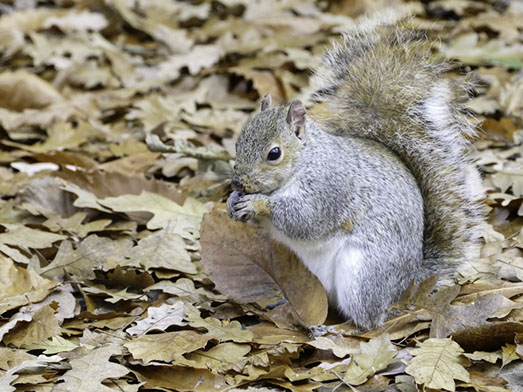
There are many theories as to why this may be. One theory is that the greys brought a disease that the reds had no resistance to. Another theory is that the red couldn’t compete with its stronger cousin for food or habitat. Yet another theory is that the grey squirrels are better adapted to life in deciduous woodland. They can manage to digest acorns which the red squirrels are unable to do. Being more adaptable, when woodland was cleared the grey could still find plenty of food.
The red squirrel also tends to be a more solitary animal therefore the decrease in habitat cannot sustain as large a number as the more gregarious greys.
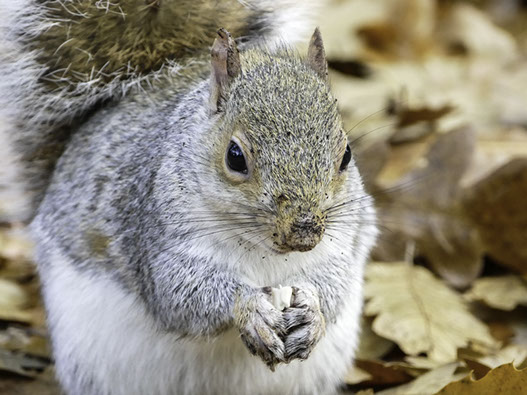
Grey squirrels live in deciduous and mixed woodland areas whereas the red squirrel is also equally at home in coniferous woodland which is why it has kept its stronghold north of the border. Due to red squirrels being lighter in weight they are advantaged in coniferous woodlands as the thin conifer branches can more easily support their weight and they can climb out to reach pine cones growing at the very end of branches.
Grey squirrels are very common throughout England and Wales but only one or two groups can be found north of Cumbria where the red squirrel remains the dominant species. In other parts of Europe the grey squirrel is non-existent and there the red squirrel reigns supreme.
A grey squirrel’s diet consists of nuts, fruit, tree shoots, roots and other garden vegetation. This often puts it into conflict with gardeners and foresters. A grey squirrel will watch a gardener planting bulbs and seeds and when the opportunity arises it will dig them up again as a snack. They strip pine cones in order to reach the seeds. The part of the cone left behind has a sort of apple core effect. Although squirrels are mainly vegetarian, in the bird nesting season eggs can also form a part of a squirrel’s diet and maybe also young nestlings. Squirrels often cause damage to newly planted trees by stripping them of bark. As a consequence the young tree will die.
In autumn, squirrels use their sense of smell and memory to collect stores of food which they hide for retrieval during winter. If you watch a squirrel burying nuts or seeds they will run around hiding food in different locations. No doubt this means that they have a better chance of finding at least some of their caches but also that other animals are less likely to find all of their stores. Although grey squirrels are charged with damaging young trees they also help propagate them as they often forget where they have planted their winter stash and the nuts and seeds then germinate in spring.
A grey squirrel can live for up to nine years. It can be distinguish from its more rare red cousin as it is larger and its ears look smaller due to them lacking the long tufts that characterise the red squirrel -the original Tufty – if you are old enough to remember the Tufty club! The term grey squirrel is deceptive as, although this squirrel is mostly grey with a white underside, its fur can have brownish and sometimes black streaks. The red squirrel is a much brighter reddish chestnut brown.
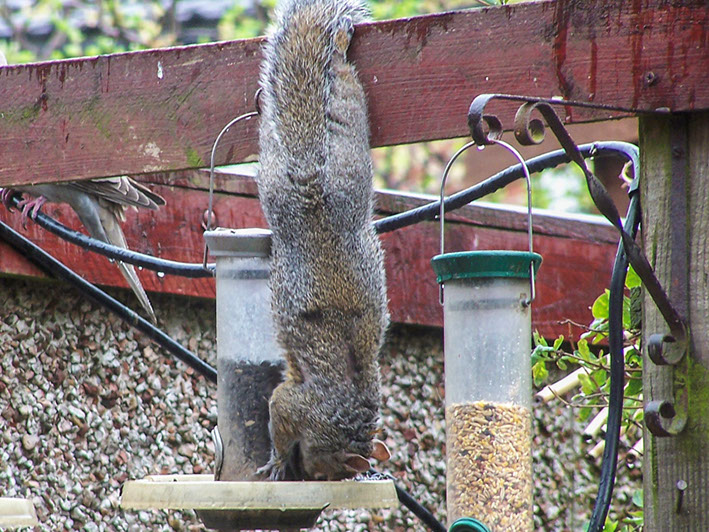
The squirrel’s bushy tail is very important as it is used almost as an extra ‘hand’ when hanging from tree branches or bird feeders!. The tail, which is as long as the rest of the squirrel’s body, also helps with balance as the animal runs along tree branches, rather like the pole that a tight-rope walker uses. When jumping from tree to tree the tail also helps steer the squirrel through the air. When anxious the squirrel will twitch its tail and when asleep the tail is curled around the body providing the animal with its own furry blanket for the cold winter months.

Squirrels are very agile creatures and can run up or down trees trunks with ease aided by very strong claws, four on its fore paws and five on the hind paws. They can leap considerable distances, up to six metres, from tree to tree. Being double jointed if they fall they usually land safely on their feet. They can apparently land safely from a fall of up to 30 metres. Apparently they can also swim!
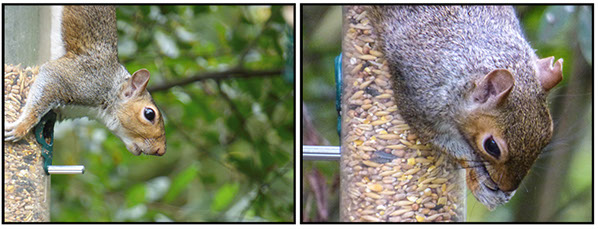
Squirrels build nests or dreys in trees. These are ball shaped and made of twigs lined with grass or moss. Here they have a litter of usually three babies either in spring or late summer. Often they have two litters in a year.

Squirrels are active during the daytime returning to their dreys shortly after sunset. They do not hibernate but will sleep in their nests during very cold spells in winter when they will share their nest for extra warmth. On milder winter days they are very active and can often be seen chasing one another around or foraging on the ground looking for their winter stores.
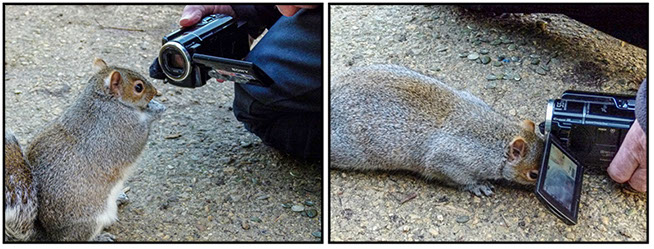
The video below and photos above were taken at Clumber park on 8 December 2012
Our Plot at Green Lane Allotments Blog | A Gardener's Weather Diary | School Vegetable Patch Website
© Our Plot on Green Lane Allotments - Please email me if you wish to use any of this site's content